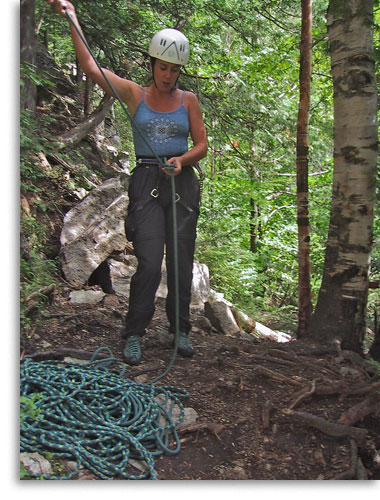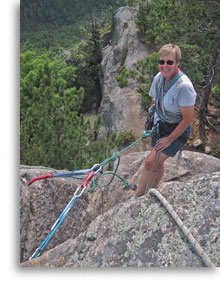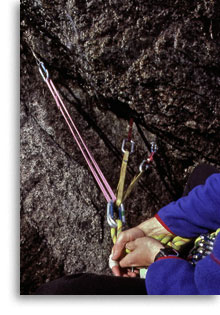
|
|
|
||||
|
Effective education facilitates the flow of knowledge from teacher to student. Learning is the goal. For this to happen the setting must not encumber student/teacher interaction and the teacher must be capable of delivering knowledge in such a way that the student can absorb it. In addition, structure, in the form of an organized teaching progression, provides a road map for learning and ensures a continuous flow of relevant information. Without all of these components, effective education is crippled. A motivated student can learn in spite of a distracting setting, poor delivery or lack of structure but this is hardly optimum. Unfortunately, crippled experiences are very common in alpine education. Unrealistic settings, unskilled delivery, and a complete lack of structure are all easy to find. Sometimes facilitators even mistake adventure objectives for learning goals, and sometimes commercial goals get in the way of education. We address these issues on our Comparing Guides, Guide Services and Climbing Schools page. The three components of effective education are discussed below: Alpine Mastery Methods describes our own unique approach to structured experiential education. |
||||
|
Effective Setting An effective setting also requires abundant and convenient teaching resources, appropriate to the educational objective at hand. Teaching crack climbing requires real cracks, glacier travel requires real glaciers. Simulated environments are just that – simulated. |
|
||||
 |
Effective Delivery Effective Structure Often called curriculum, a good methodology does not constrain teaching so much as direct and organize it. The best teachers use curriculum as a guide, rather than treating it as gospel. Structure assures a teacher’s delivery skills move the learning process in a well-defined direction. |
||||
|
Alpine Mastery Methods Standard Practices Determining an appropriate set of standard practices requires a broad knowledge of the possible options and considerable experience sorting out their pros and cons in real-world situations. This type of knowledge is accumulated over a long time period from a variety of sources, the most valuable of which is experience. To set standard practices we first determine priorities, and this is predicated upon knowing where and how standard practices will most-often be employed for each of our activities. Practices that make sense in one setting might well be unwieldy elsewhere. For the most part, we optimize our standard practices for traditional climbing and skiing environments rather than the manipulated environments found in controlled or artificial settings. We generally place simplicity near the top of the list, followed by versatility and consistency with our other practices. In the mountains, a seemingly near-ideal solution to a technical problem that involves complex rigging or specialized equipment is almost always less desirable than simpler solutions with broader applicability. Practices that can be applied in a wide variety of situations reduce complexity and with it, the likelihood of making mistakes. On the other end of the spectrum, oversimplification can be just as problematic as excessively complex solutions. An in-depth understanding of the physical principles and psychological factors governing a particular situation is required to determine the best approach. Often the specialized practices that might be ideal for a professionally guided situation will differ significantly from the more broadly applicable ones best suited to recreational alpinism. In these instances we first teach, and use, practices suitable for the recreational alpinist. These are the practices we emphasize in our instructional programs. Once a student has mastered these core practices we may introduce specialized practices or, we may continue to employ core practices in the interest of consistency. In addition to carefully defining which practices we will use, we also codify methods for teaching these practices to others. In many cases we have several different teaching approaches, each suitable for a different learning style or situation. Beyond these, an instructor is always free to find new ways to better communicate practices. Climbing and skiing are quite different in nature and our practices reflect this. Whereas specific safety techniques are often central to teaching climbing, the kinesthetics and mechanics of movement tend to provide more of the central framework for our skiing practices. These “standard practices” are the building blocks we glue together to form the Alpine Mastery Methods. Skill Sets, Lessons & Courses Our skill sets, lessons and courses are precisely defined and their relationship to one another has been carefully constructed to provide a continuous flow of relevant information. For example, our Rock Mastery Method includes more than 240 individual skill sets grouped into 15 lessons, ranging in length from 90 minutes to 6-1/2 hours each – and that is just to complete our Level II milestone! Depending upon your experience and schedule, this milestone can be reached by any of three different course sequences. Achievement Milestones Evaluation Tools |
|
||||
|
Progressive Instruction By Design – Our Curricula Level I Courses - These are introductory courses for people who have had little or no experience with a particular activity. They lay the foundation essential for all of our other courses. Level II Courses - These intermediate courses reinforce and build upon the basics presented in Level I. The many new skills introduced at this level are developed through practice in a variety of settings. Emphasis is placed on becoming more proficient with movement and technical skills. Level III Courses - These advanced courses are for people who have a solid grasp of our Level II skills and are ready to refine them for more demanding situations. Emphasizing specific aspects of an activity, these courses will help you become the very best alpinist you can possibly be! For more information regarding specific instructional methodologies for each activity, please visit: |
||||
|
~ Mountain Adventures In the Adirondacks Since 1985 ~ |
|||
|
Alpine Adventures, Inc. |
(518) 576-9881 |
||





